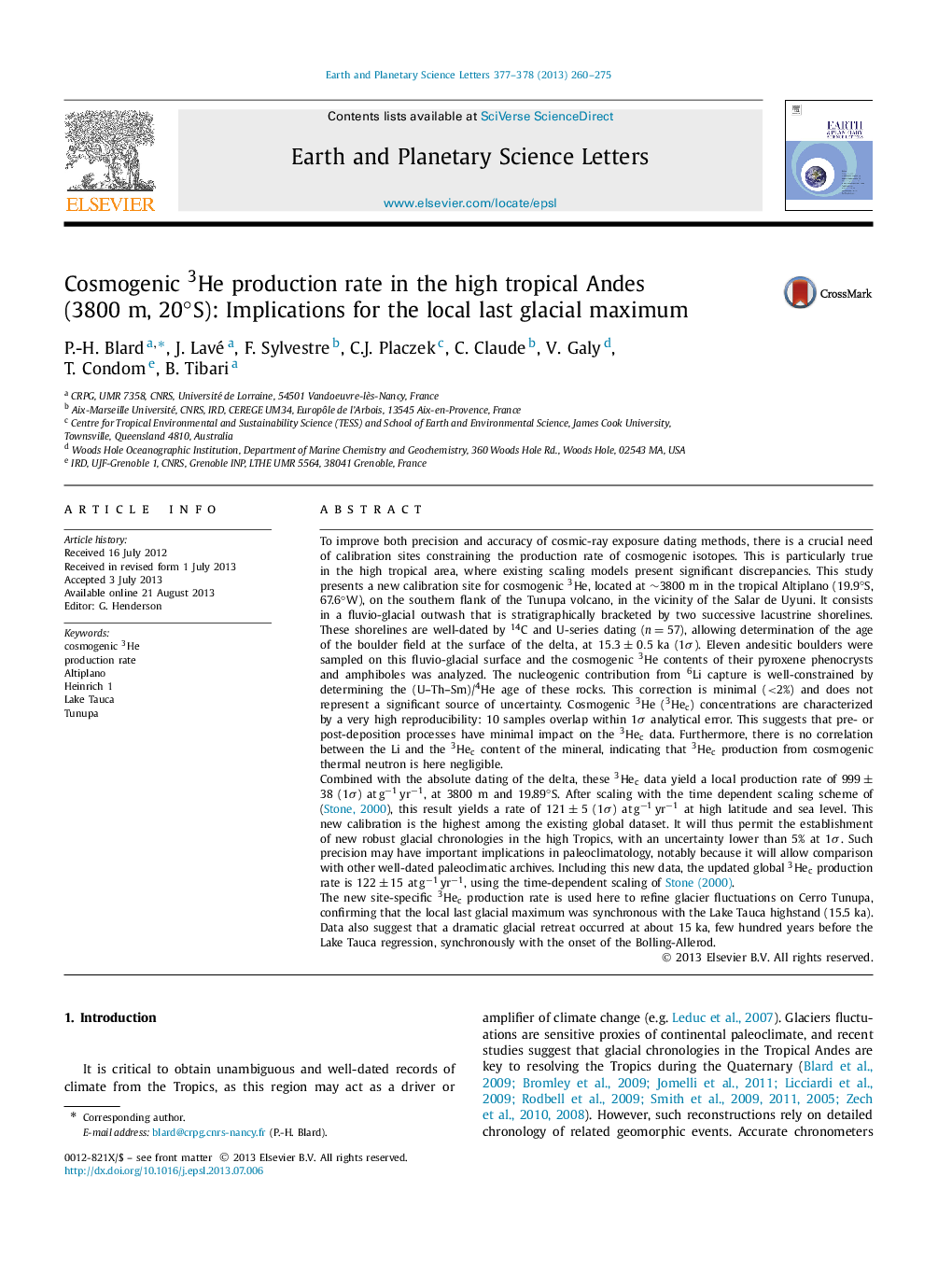| کد مقاله | کد نشریه | سال انتشار | مقاله انگلیسی | نسخه تمام متن |
|---|---|---|---|---|
| 6430025 | 1634778 | 2013 | 16 صفحه PDF | دانلود رایگان |

- A new calibration site for cosmogenic 3He in the high tropical Andes (3800 m, 20°S).
- Independent dating from U-Th and 14C of lacustrine paleo-shorelines at 15.3±0.5 ka (1Ï).
- The new high elevation 3He production rate agrees with the rates calibrated at lower elevations.
- Refined glacier chronology indicates synchrony between Lake Tauca and Altiplano LGM at 15.5 ka.
To improve both precision and accuracy of cosmic-ray exposure dating methods, there is a crucial need of calibration sites constraining the production rate of cosmogenic isotopes. This is particularly true in the high tropical area, where existing scaling models present significant discrepancies. This study presents a new calibration site for cosmogenic 3He, located at â¼3800 m in the tropical Altiplano (19.9°S, 67.6°W), on the southern flank of the Tunupa volcano, in the vicinity of the Salar de Uyuni. It consists in a fluvio-glacial outwash that is stratigraphically bracketed by two successive lacustrine shorelines. These shorelines are well-dated by 14C and U-series dating (n=57), allowing determination of the age of the boulder field at the surface of the delta, at 15.3±0.5 ka (1Ï). Eleven andesitic boulders were sampled on this fluvio-glacial surface and the cosmogenic 3He contents of their pyroxene phenocrysts and amphiboles was analyzed. The nucleogenic contribution from 6Li capture is well-constrained by determining the (U-Th-Sm)/4He age of these rocks. This correction is minimal (<2%) and does not represent a significant source of uncertainty. Cosmogenic 3He (3Hec) concentrations are characterized by a very high reproducibility: 10 samples overlap within 1Ï analytical error. This suggests that pre- or post-deposition processes have minimal impact on the 3Hec data. Furthermore, there is no correlation between the Li and the 3Hec content of the mineral, indicating that 3Hec production from cosmogenic thermal neutron is here negligible.Combined with the absolute dating of the delta, these 3Hec data yield a local production rate of 999±38 (1Ï) atâgâ1âyrâ1, at 3800 m and 19.89°S. After scaling with the time dependent scaling scheme of (Stone, 2000), this result yields a rate of 121±5 (1Ï) atâgâ1âyrâ1 at high latitude and sea level. This new calibration is the highest among the existing global dataset. It will thus permit the establishment of new robust glacial chronologies in the high Tropics, with an uncertainty lower than 5% at 1Ï. Such precision may have important implications in paleoclimatology, notably because it will allow comparison with other well-dated paleoclimatic archives. Including this new data, the updated global 3Hec production rate is 122±15 atgâ1yrâ1, using the time-dependent scaling of Stone (2000).The new site-specific 3Hec production rate is used here to refine glacier fluctuations on Cerro Tunupa, confirming that the local last glacial maximum was synchronous with the Lake Tauca highstand (15.5 ka). Data also suggest that a dramatic glacial retreat occurred at about 15 ka, few hundred years before the Lake Tauca regression, synchronously with the onset of the Bolling-Allerod.
86
Journal: Earth and Planetary Science Letters - Volumes 377â378, September 2013, Pages 260-275